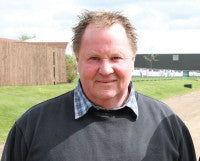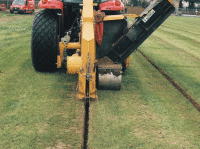Drainage Improvements - Assess and identify...

In the last two articles, we looked at working with high end pitch systems which are more often out of the reach of lower league, non-league and amateur clubs. At higher league level, whether or not a pitch is reinforced by one of the systems discussed previously, it will be of a reasonably consistent nature in terms of construction, with either a sand over gravel carpet or a reasonable drainage system. Unfortunately, this is often not the case in the semi-professional and amateur leagues, be it rugby or football.
In the lower leagues, you can find pitches that vary enormously, both in terms of construction, if indeed there is any, and also the quality of the growing medium that is expected to sustain a grass sward through the winter months. Given this scenario, what can be done to maintain or improve standards of play at these lower level clubs?

When looking at drainage improvements, there are several factors that need considering. Clearly, the type of soil, annual rainfall and topographical details will have an effect on the system that is chosen, but so too should the available maintenance budget. As a general rule the higher the specification of the pitch, the more it will cost to maintain its performance; clubs need to ensure that they do not create a pitch that they are unable to maintain properly.
A good example of this is the standard pipe and slit system, which has been the mainstay of sportsfield drainage for several decades. Few would argue at its effectiveness, and it is still the system of choice in many situations, but many installations have failed prematurely through lack of maintenance, rendering much of the investment made a waste of money.

Pipe drains effectively control the water table under a pitch, preventing the soil becoming saturated and, therefore, allowing surface water to percolate through the soil profile. If they are topped off with a free draining material, they will also enhance the surface drainage within a metre or so of the drain.
The next consideration will be surface drains. These are used where the composition of the topsoil and subsoil is such that natural drainage is minimal, and are designed to provide a free-draining route for surface water to reach the underlying pipe drains. Traditional sand slits, incorporating sand and gravel backfill, can be used where significant lateral movement of water is required to carry water between drainlines that are up to 10m apart. In situations where pipe drains are closer together, then slits containing only sand can be installed to remove surface water.
In general, surface drains are less robust than pipe drains: even the best sand slits rarely remain efficient longer than ten years, whilst the lifespan of gravel bands and sandbands can be considerably less than this. Longevity is also affected by the level of use and ongoing maintenance. If you can retain a sandy playing surface, then surface drains will continue to work well, but allow mud to form and they will quickly cap off, reducing their efficiency significantly.

If there is a good budget, with money available for future maintenance and further drainage installation, then an even split between pipe drains and surface drains will be the way to go. This could take the form of a traditional pipe and slit system or close-centred pipes with Koro Topdrains, both of which will offer high rates of surface drainage.
At the other end of the scale, where future funds are likely to be limited, then spending a greater portion of the budget on installing pipe drains would be more appropriate. An example would be close-centred pipe drains, perhaps at 3m centres, with sandbands installed if the budget allows. This type of system will give a good foundation to the pitch for many years, and one which can be added to in the future should funds become available.
Next time, we will look at what cultural and mechanical practices are available to build on the foundations of a well installed drainage system.
